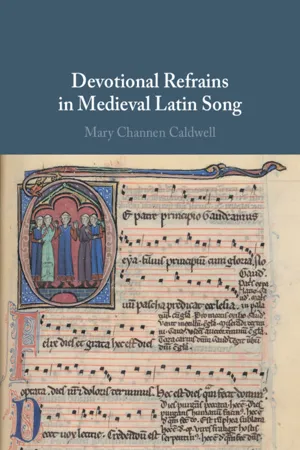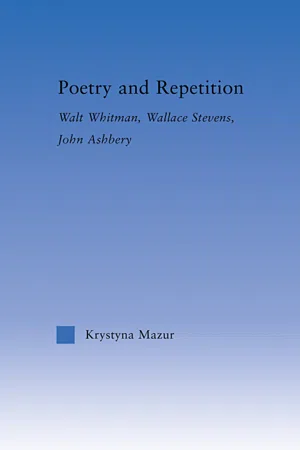Literature
Refrain
A refrain is a repeated line or phrase in a poem or song that is used for emphasis or to create a sense of rhythm. It can also be used to convey a particular theme or message throughout the work. Refrains are often found in ballads, hymns, and other forms of poetry and music.
Written by Perlego with AI-assistance
Related key terms
1 of 5
4 Key excerpts on "Refrain"
- eBook - ePub
Tearing the World Apart
Bob Dylan and the Twenty-First Century
- Nina Goss, Eric Hoffman(Authors)
- 2017(Publication Date)
- University Press of Mississippi(Publisher)
12 Without the Refrains or choruses, the live versions of some songs would have remained nearly inscrutable, lacking the familiarity a concert audience expects despite the impeccable sound system. This illustrates how crucial a role the Refrain has in establishing communication between the performer and the audience, and giving the audience a sense of familiarity and identification.Refrain, BURDEN, REPETITIONThe Refrain may easily be confused with other poetic devices such as repetition, and the boundaries between these devices prove to be cumbersome. Therefore, a brief explanation of the term is necessary. According to The New Princeton Encyclopedia of Poetry and Poetics, the Refrain is “A line, lines, or part of a line repeated verbatim at intervals throughout a poem, usually at regular intervals, and most often at the end of a stanza—a burden, chorus, or repetend.”13 The burden refers to the repetition of a whole stanza, the chorus to the repetition of a stanza by a group of people, and the incremental repetition or the repetend to the repetition of words in an irregular fashion. Here the terms chorus and Refrain will be used interchangeably, with the awareness that the former foregrounds the musical and the latter the textual/verbal aspect of the lines repeated.Though the Refrain is very common in, and arose out of, oral poetic forms, it also appears in written poetry. Edgar Allan Poe acknowledged the poetic and architectonic import of the Refrain in written poetry. In his essay “The Philosophy of Composition” (1846), Poe defiantly reveals the secrets of his craft, explicating the steps he followed while composing his narrative poem “The Raven” (1845). Having decided on the “the length, the province, and the tone,”14 Poe searches for a keystone upon which the whole structure of the poem should depend, and concludes that architectonically the Refrain is the most valuable and popular tool: “As commonly used, the Refrain, or burden, not only is limited to lyric verse, but depends for its impression upon the force of the monotone—both in sound and thought. The pleasure is deduced solely from the sense of identity—of repetition.”15 Because it is short and easy to memorize, the Refrain helps the reader to easily identify the text/song he or she is reading or listening to. The Refrain, then, is one of the elements that facilitate both the process of cognition (identification) and that of pleasure (repetition) in the reception of a poem. In musical terms, it is like a percussive instrument that highlights the main theme, and, in textual terms, it is a significant item in the construction a poem. In “The Raven,” however, Poe does not stick to monotony; instead, he attempts to create diversity in unity by limiting the Refrain to one single word or sound and introducing variety within the repeated line. In Modern Times - eBook - PDF
The Song in the Story
Lyric Insertions in French Narrative Fiction, 12-14
- Maureen Barry McCann Boulton(Author)
- 2016(Publication Date)
2 In French, the same word is used both in this sense and, by extension, to designate short lyric pieces which occur either independendy or inserted into other works, even though they are not repeated. Thus, the Dictionnaire des Lettres Franpaises defines Refrain in the latter sense as une citation de paroles et musique inseree dans un 1. Cf. Cerquiglini, Typologie, p. 9, and Le montage des formes: l'Exemple de Guillaume de Machaut, Perspectives medievales, 3 (1977): 23-26. 2. Oxford English Dictionary: Compact Edition (Oxford: Clarendon Press, 1972), II, p. 2466. 244 Chapter 7 texte different, que celui-ci soit lui-meme chante ou non. 3 Most of the lyrics cited were doubdess recurring in their original context, but their increasing use out of context led to their being assigned the status of a separate genre. As a result, new Refrains were composed in imitation of the others, and even though they were never employed as a recurring element, they were still considered to be Refrains , because they were so conceived of by their authors. 4 In considering the relationship of the Refrain to its surrounding text, Nico van den Boogaard commented that it seems always to occur in symbiosis with another literary genre. 5 Michel Zink, seeking to refine the definition of the relationship between the two parts, turned to the etymol-ogy of the word. 6 Refrain comes from refractum , the past participle of refrtnßere , which usually means to break. 7 The Refrain, then, is something that breaks, or perhaps, interrupts the poem. As Zink points out, the Refrain is set off by meter, rhyme, and melody from the stanza and usually introduces some change in the sense as well. It seems a foreign element, even though it fits well into its setting, and creates the impression of an apt quotation. 8 While it may interrupt the sense of the stanza, the Refrain also determines its structure. - eBook - PDF
- Mary Channen Caldwell(Author)
- 2022(Publication Date)
- Cambridge University Press(Publisher)
The Refrain is powerful not solely due to the rhetorical potential of repetition – although that is significant – but also by means of the Refrain’s relationship to poetic, musical, and liturgical performance practices. Evinced in poetic language and grammar, form, musical settings, and scribal cues, the Refrain in devotional Latin song brings individuals together in the moment of performance through the 1 For a comparable question and discussion with different outcomes around the French Refrain, see Butterfield, Poetry and Music, 75–121, and Saltzstein, Refrain. 104 act of remembering together, responding collectively, and worshipping communally. With roots in the responsorial, litaneutical, and ejaculatory Refrains and repeated prayers of the liturgy, the Refrain evokes both real and imagined performance practices around Latin song that contribute to its agency within the devotional and musical lives of medieval communities. The Refrain carries cultural, musical, and poetic weight precisely because it rarely reflects the utterance of an individual, but instead expresses the voice of the community, whether defined as narrowly as a choir in a local church, or as broadly as the clergy, or even the entire church. This chapter explores the meaning of the Refrain in and for communal performance. For the communities who created, sang, and transmitted devotional Latin song, the Refrain afforded a moment for the collective, shared experience of remembering and responding. It has long been assumed by scholars and performers that Refrain forms in medieval song initiated, on a practical level, a call-and-response format, with strophic material performed by soloists and the Refrain by a choir. 2 While there is an attractive simplicity in the equivalence of performance practice to form, the reality is more complex. - eBook - ePub
Poetry and Repetition
Walt Whitman, Wallace Stevens, John Ashbery
- Krystyna Mazur(Author)
- 2006(Publication Date)
- Taylor & Francis(Publisher)
Introduction
Introduction Repetitions structure our attention to what we read. The recurrence of images, words, concepts, figures creates a rhythm—temporal and spatial—which underlies reassuring moments of recognition: we make sense of the text by leaps of repetition, through repetition as leaps of sense. Not the only way, but one of the more important ways of relating various semantic and formal elements, repetition anchors our interpretations.The standard, or most conventional, dictionary definitions of repetition presuppose an independent existence of an original. That original is coupled—via repetition—with a duplicate or a replica which reproduces it more or less faithfully.1 Along these lines, an article in The Princeton Handbook of Poetic Terms defines repetition as “the basic unifying device in all poetry”; it helps to organize, ornament, associate, and emphasize elements in a poem. According to the Handbook, repetition of similar endings in rhyme “binds lines together”; the repetition of words, and the repetition of phrases, lends unity and/or emphasis. Much more rarely, repetition performs functions other than unifying. And so, allusion—a special case of repetition—may have a diffusive, rather than unifying effect, often seeming to be “an extraneous, if graceful, decoration.” Assonance may also have a “decorative or supplemental function.” Repetition of a phrase may “emphasize a development or change by means of the contrast in the words following the identical phrases.” A line, when repeated, may acquire “altered and enriched significance.” A line may occasionally be repeated for closure. Still, given all these other possibilities, the Handbook insists that repetitions primary function is to unify a poetic text and its other, less stabilizing functions, are “extraneous,” an exception to the rule.2
Index pages curate the most relevant extracts from our library of academic textbooks. They’ve been created using an in-house natural language model (NLM), each adding context and meaning to key research topics.



